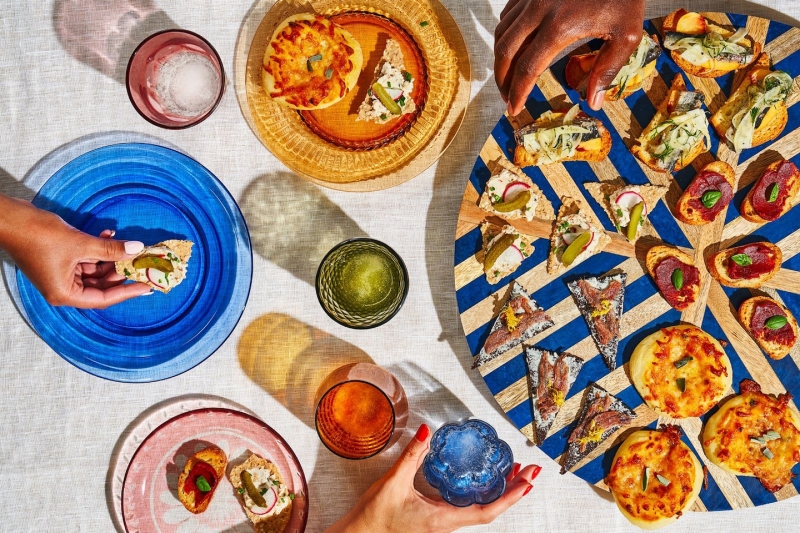Contents
Sampling stuzzichini, the free snacks that accompany aperitivo hour, is one of the pleasures of traveling Italy.
Key takeaways
Summary is AI-generated, newsroom-reviewed.
- Stuzzichini are small, complimentary snacks served with drinks in Italy.
- A new book explores Italian aperitivo culture and snack variety.
- Tips for enjoying stuzzichini: expect surprises and don’t overindulge.

By Natalie B. Compton
The love story started with a paper bag.
It was the thick of the pandemic, and Stef Ferrari had just moved to Italy to study the country’s history and culture at the Istituto Lorenzo de’ Medici in Florence. She stopped by a historic cafe for a drink and was surprised when the server handed her a bag along with her paper cup (the cafe was serving takeout only while the world waited for a vaccine).
“I was like, ‘I didn’t order anything, this must be for someone else,’” remembers Ferrari, an Emmy-winning producer and food writer — no relation to the racing family. But the server at Caffe Gilli insisted. Inside the bonus bag was a tray of bite-size snacks: a paper cup of green olives, homemade crackers and brioche sandwiches with garlicky goat cheese to go along with her drink.
That was Ferrari’s introduction to stuzzichini, the complimentary snack that often comes with your drink at a bar in Italy. As she saw it, the appetizers represented “a gesture of hospitality and care,” and the beginning of an obsession.
Like tapas in Spain, stuzzichini can be simple or elaborate, from a bowl of peelable lupini beans to a fancier spread — like her Florentine experience — just a small something to whet the appetite. The tiny acts of kindness sparked a years-long investigation into the custom that led to Ferrari’s new book, “Stuzzichini: The Art of the Italian Snack.”
The name translates to appetizer or canapé, coming from the Italian word for “stimulate” or “tantalize,” as these little dishes are designed to do just that. They’re an essential component of aperitivo culture, the Italian ritual of gathering for drinks before dinner, as Italians frown on drinking with an empty stomach.
“The classic aperitivo ritual is going and getting one drink, something light, not getting a buzz on, and being convivial with friends or colleagues,” said Rome-based cookbook author and tour guide Katie Parla. “It’s something you do before your meal to get your body ready.”
American enthusiasm for aperitivo culture has been climbing for years, but mostly focused on the beverage side of the ritual. While aperitivo drinks like the Aperol spritz stole the show, aperitivo snacks remained an unsung hero.
Ferrari’s book is an exception. It’s a love letter — part cultural guide, part cookbook — to the bites that help open up your appetite for dinner. We asked Ferrari for her tips on finding and enjoying the snacks on your next trip to Italy.
Where to find stuzzichini
Stuzzichini can be as simple as a cup of peanuts or more involved, like “a beautifully composed puff pastry with salmon mousse,” Ferrari said.
You’ll find them across Italy in a bar, cafe, enoteca (wine bar) or cocktail spot during happy hour. The Italian version, that is.
“It can be little bit later than what the U.S. would consider happy hour,” Ferrari said. “You’re probably looking at 6, 7, 9 — sometimes even later.”
Ferrari has never outright ordered stuzzichini. They were always something that arrived at the table or bar top as a surprise. Some establishments will advertise stuzzichini with a sign out front to draw in customers. Others will just provide you with a serving along with your drink order.
Depending on where you’re traveling, they might not be called stuzzichini. In Venice, for example, they’re cicchetti.
“The word stuzzichini is pretty particular to the central part of the country,” Ferrari said. “If you go south, there’s a different word for it. If you go north, there’s a different word for it, but the concept is very much the same.”
And like the name, stuzzichini can have regional differences. Each one can be an expression of a place, Ferrari said.
“Most of the time it’s made with whatever the local specialty is … a particular kind of pork or a particular kind of cheese,” she said.
In northern Italy, Ferrari found snacks with Austrian influences, like Liptauer cheese on a cracker. Up in the Dolomites, she was served a potato pancake. In Sicily, she encountered snacks with North African spices, raisins, currants and dates.
Spontaneity is part of the fun
More often than not, they’re surprising. Go back to the same bar the following night, and you might find the same bite or you might be served the same kind of dish but with another ingredient at the heart of it (like another style of crostini, the classic canapé of grilled bread with toppings). It could be something else entirely. Each time Ferrari returned to Caffe Gilli in Florence, where she first encountered stuzzichini, the snack was never exactly the same.
“They’re totally ephemeral,” she said.
That’s because the free snacks can be a way for an establishment to work through its pantry while giving customers something to soak up their spritz.
“It’s all about minimizing waste and being able to stretch ingredients,” Ferrari said. “That’s why they’re different all the time. Because a lot of the times they’re kind of just like made up on the fly.”
Stuzzichini’s ephemeral nature is part of the fun. Enjoying these fleeting snacks can be an antidote to our tendency to over-plan travel.
“I feel like travelers now Google everything in advance,” Ferrari said. “They find all the menus for every place they want to go. They’ve read about it, they’ve seen it on TV and it’s all but fait accompli by the time you’re there … there’s no discovery to it anymore.”
Not the stuzzichini. Even if you’ve researched the bar to the high heavens, the snack du jour is bound to be a surprise. Plus, it’s a good conversation starter.
“You start talking about ‘What is this product, where does this come from? What’s the inspiration?’” Ferrari said. “And of course, [the staff are] all so proud to come over to the table and tell you … it opens up like a completely new and exciting avenue for travel.”
Essential stuzzichini etiquette
Think of stuzzichini as a small token of appreciation from the kitchen. Even though Ferrari says it could end up being your “girl dinner” it’s not designed to be a meal. You may be treated to more than one serving if you order more than one drink, but don’t expect a free feast in exchange for ordering one spritz.
“Particularly if there’s a buffet situation, which it is occasionally the case … don’t abuse it,” Ferrari said. “It’s a gesture. It is meant to make you comfortable and at ease. But it is not sustainable for them to have a bunch of study-abroad students pillaging the buffet.”
No matter how tasty the snacks are, don’t overdo it on the drinks, either. “Public drunkenness in general is just frowned upon [in Italy],” Ferrari said.
Her last tips: be gracious, be grateful and free up the table if you’re done with your drink.
Photographs and illustration were excerpted from STUZZICHINI by Stef Ferrari. Copyright © 2024 by Stef Ferrari. Photographs by Deepi Ahluwalia. Illustrations by Stef Ferrari. Used with permission of Voracious, an imprint of Little, Brown and Company. New York, NY. All rights reserved.
Where to go
Our favorite destinations: Take our destination quiz to choose your own adventure. Then read about 12 dream destinations at the top of our wish list — without the crowds.
Travel like a local: Residents share their favorite places in our top city guides: New Orleans, Rome, Tokyo and Mexico City.
National parks: Explore tips from locals for visiting Yosemite, Glacier and Everglades.
Tales from the road: Trace a route along the southern coast of Puerto Rico. See how jamón gets made in the heartland of Spanish pork.

